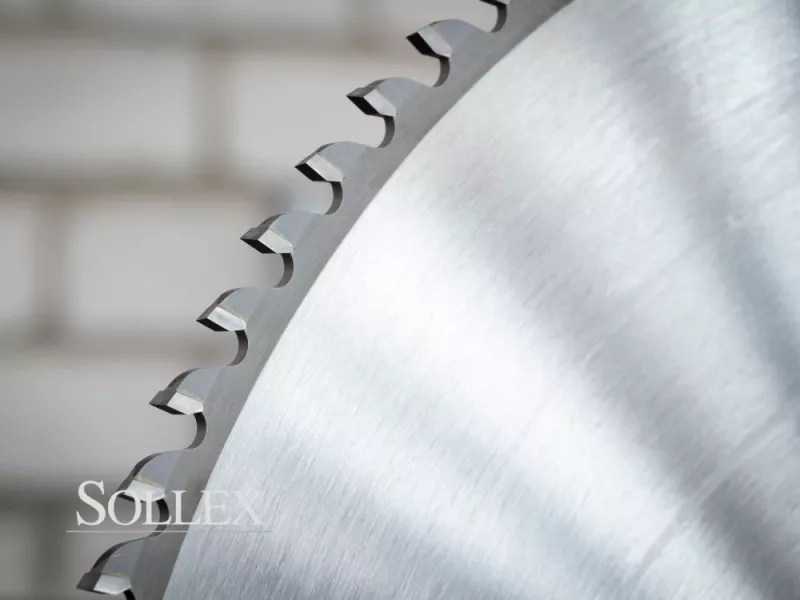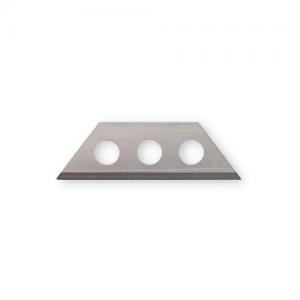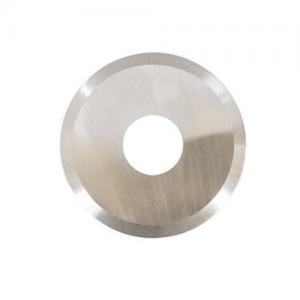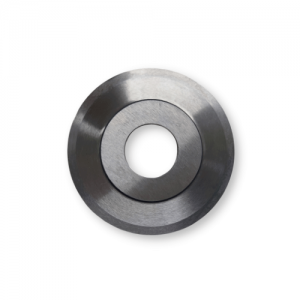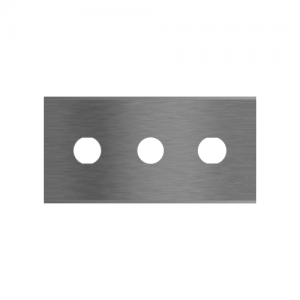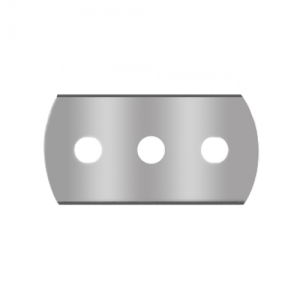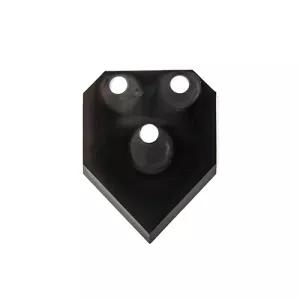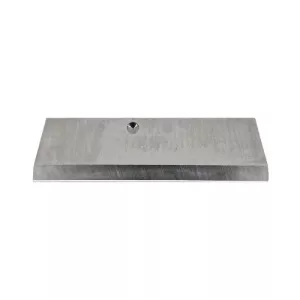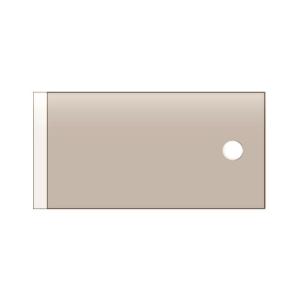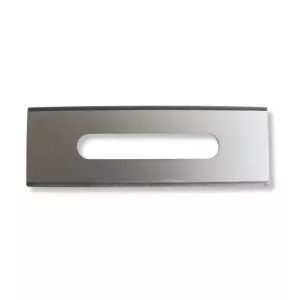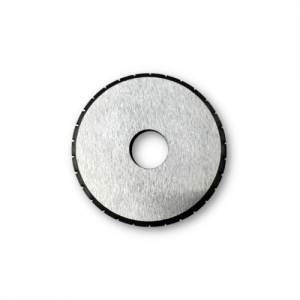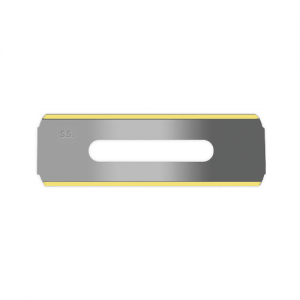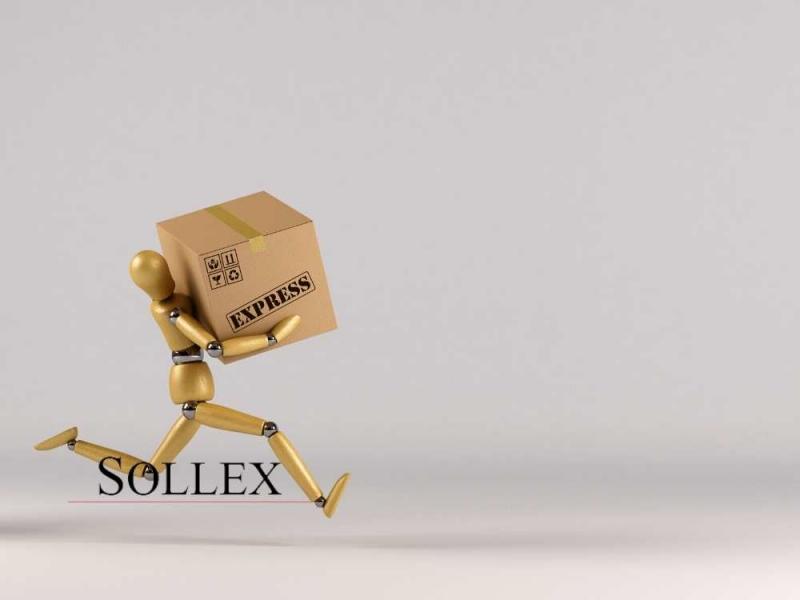Learn About Industrial Knives & Blades from A to Z
Types of Industrial Blades and Machine Knives according to their Different Shape or Application. Types of bevels. Design of industrial knives.
Choosing the right cutting tool can sometimes seem like a daunting task, so if you want to learn more about where to get the best industrial blades for your cutting tools and equipment, you've come to the right page. This text describes in detail different machine knives and industrial blades suitable to be mounted in machines for cutting applications.
Content:
- Introduction
- Definitions of industrial knives and blades
- Edges of the blade
- Knife edge grinding
- Types of blade bevels
- Materials for industrial knives and blades
- Circular Knives
- Top Male Slitting Knives (Dish knives)
- Bottom Female Knives
- Perforator Crush Cutter
- Toothed / Serrated knives
- 3-Hole Razor Blades
- Slotted Slitter Razor Blades
- Injector Blades
- Trapezoid Blades
- Pointed Machine Blades
- Granulator Knives & Pelletizer Blades
- Long Machine Knives
- Coatings of industrial machine knives
- Order Machine Knives and Blades
Introduction to Machine Knives and Industrial Blades
In industry, machine knives—also known as industrial knives, slitter knives, slitting blades —are used for cutting, slitting, and converting various materials. Better and more durable blades evolved from throughout time from improved materials.
Early 19th-century industrialization started to see knives and cutting tools applied in the manufacturing sector. Depending on a great range of material to cut, the evolution and demands of worldwide industrial production define today the diversity of cutting tools and blades available. With industrial knives and blades, most often used materials for cutting include paper, cardboard, tape, polyester, plastics, plastic film and foil, foam, felt, rubber and metal foil.
Sollex designs, optimizes, and produces knives for industrial uses with rigorous standards on material and product quality. In Sweden and Northern Europe, we rank as the top industrial knife and blade provider. Our clients include food, paper and packaging, plastic industrial manufacturers. Different forms, grindings, and hole patterns abound on several of the blades.
Industrial knives are used for:
- cutting plastic film, foil, plastic packaging
- production of paper, cardboard, paper products
- rubber and rubber goods cutting
- plastic processing
- pelletizing
- light industry
- food industry
- production of pharmaceuticals and medical equipment
- production of advertising materials and printing products and much more
About Industrial Knives & Slitting Blades
This chapter defines industrial knives and blades in respect to characteristics and design.
Differences Between Industrial Knives & Razor Blades
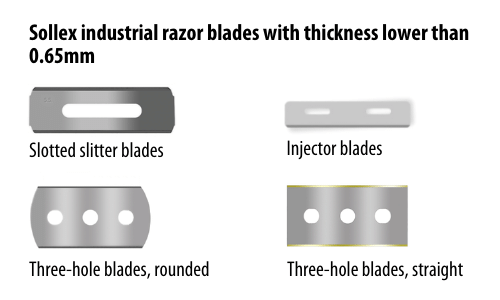 Industrial razor blades are easy to handle and used correctly to provide the best quality cut. Industrial knives are thicker than 0.65mm designed to cut various materials. We define industrial blades as a blade with thickness lower than 0.65mm. The industrial razor blade has an even thinner design with maximum 0.40mm thickness. But in practice to be successfully used as a razor blade thickness below 0.25mm is needed. Thin razor blades provide less friction and damage to the material, hence a cleaner cut.
Industrial razor blades are easy to handle and used correctly to provide the best quality cut. Industrial knives are thicker than 0.65mm designed to cut various materials. We define industrial blades as a blade with thickness lower than 0.65mm. The industrial razor blade has an even thinner design with maximum 0.40mm thickness. But in practice to be successfully used as a razor blade thickness below 0.25mm is needed. Thin razor blades provide less friction and damage to the material, hence a cleaner cut.
Additional advantages with razor blades are minimized dust and web breaks. Industrial razor blades are used to cut many different materials such as plastic film and foil with additives, paper and non woven.
Use as thin blade as possible
A thinner blade gives a better cut. Therefore you should try to use as thin blade as possible. Thinner blades work and cut better because it requires less force and provides less shear to the material you are cutting. A thinner blade helps to avoid blade breaks and provides a cleaner cut.
45-degree angle to the material
Most blades and materials are engineered to operate at a 45-degree angle while cutting the material web. Reduced angles facilitate cutting action and extend wear distribution throughout a greater length of the cutting edge. A pristine surface or cutting edge minimizes friction. Decreased friction leads to decreased heat generation and material wear during cutting. This results in a more refined cutting edge.
Specifications of Industrial Blades
Industrial knives can be characterized by the following parameters: edges of the blade, grinding from one or two sides, and the number of bevels.
Industrial Blade Cutting Edges
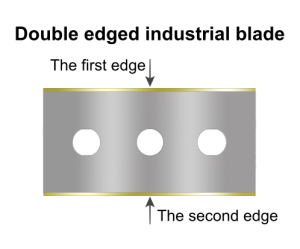
The first definition on how to grind an industrial knife or blade is to define how many edge the blade will have. This means the number of sharp edges of the blade: single edged, double edged, triple edged etc. 98% of all blades consist of one or two edges. But in addition to the one and two edged blades the are pointed blades and almost circus blades due to multiple edges.
Knife Edge Grinding
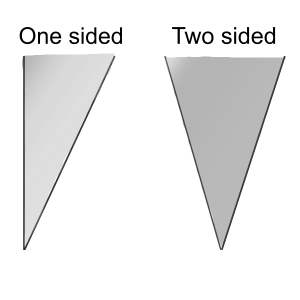
The second definition on how to grind a blade is to look on the grinding from the side. Grinding can be done on one or two sides. It means how many sides of the knife blade that is grinded. If the knife is one sided than the other side is flat, if two sided - both sides are grinded.
98% of all knives are grinded from two sides. This provides an easy and smooth cut. But if you want to cut thin material slices and fully protect the fibers of the material you cutting a one sided blade can be suggested. For example a Japanese sushi chef cutting fish are usually cutting it with a very long (to be able to to it in one cut) extremely sharpened one sided knife. There are some other industrial examples where a one sided blade is the preferential choice when it come to grinding. Cutting packaging paper with a circular knife can be one example. But in general, if you do not know that you need a one sided grinding go with two sided.
Types of Blade Bevels / Grinding
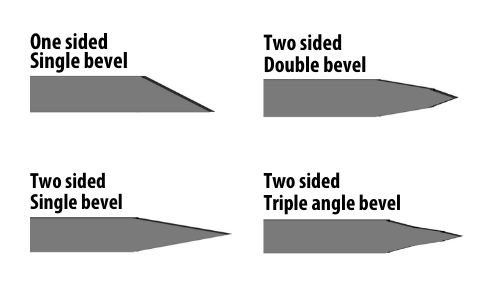 The third definition on how to grind a blade is how many bevels the grinding has. The general type of edge grinding are: single bevel, double bevel, and triple angle bevel.
The third definition on how to grind a blade is how many bevels the grinding has. The general type of edge grinding are: single bevel, double bevel, and triple angle bevel.
What is the definition of an industrial knife bevel? A bevel is by definition a sloping surface A bevel refers to a surface that has been grinded to the knife's edge. Looking closer on the knife we can grind the steel with different angles. Using multiple grindings with different angles we create bevels.
Looking close on the grinding a knife will reveal a slight angle incline that runs down to the edge. This is the bevel. If there is one on both sides, then it is a double bevel knife. Bevels are also referred to as facets.
In general we can conclude that a 2 bevel or 2 facet blade gives durability and sharpness. 3 bevels of facet grinding gives intricate cuts. For slitting a hollow ground blade is preferred and finally for tough scraping a Chisel blade design is preferred.
One finding about bevels is that fewer facets gives the blade resilience. More facets, results in finer cuts.
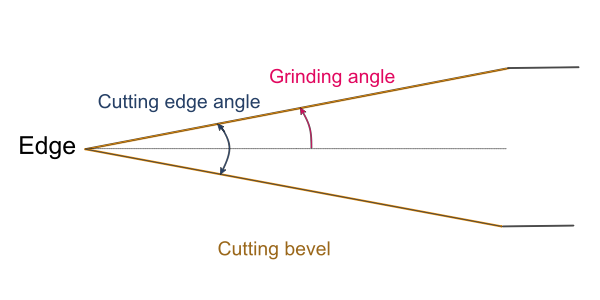 Most applications are simply too tough for single-facet blades. So the choice is toughness of a two-facet or sharpness of a three-facet edge. Multifaceted grinding and burr-free edges provide the best cutting results, due to cleaner edge cuts and reduced blade breaks.
Most applications are simply too tough for single-facet blades. So the choice is toughness of a two-facet or sharpness of a three-facet edge. Multifaceted grinding and burr-free edges provide the best cutting results, due to cleaner edge cuts and reduced blade breaks.
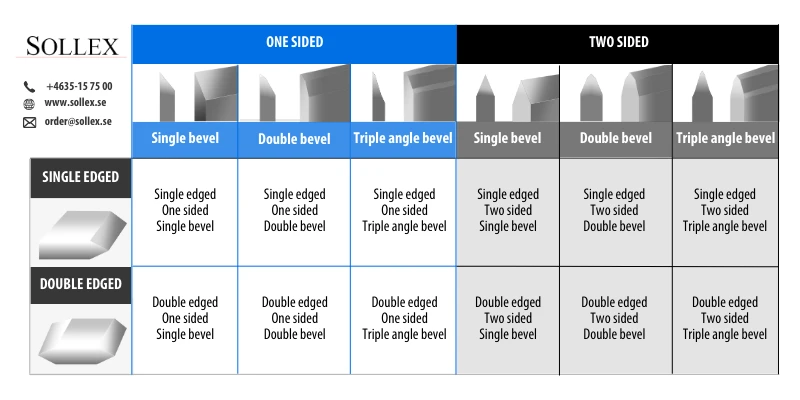
Other Characteristics Affecting the Design of the Industrial Knife
- shape and diameter of the hole in the knife for fixation in knife holders;
- outer and inner diameters in case of a circular knife
For example Sollex professional circular knife for industrial production R105 in HSS-M2 steel was developed for the plastic film manufacturing company in Dubai. This knife is double-sided, double-grinded to be mounted on a 34 mm shaft. The dimensions of the circular knife are 105x34x1.5mm, where its outer-Ø diameter (D1) is 105mm, the inner-Ø diameter (D2) is 34mm and thickness - 1.5mm)
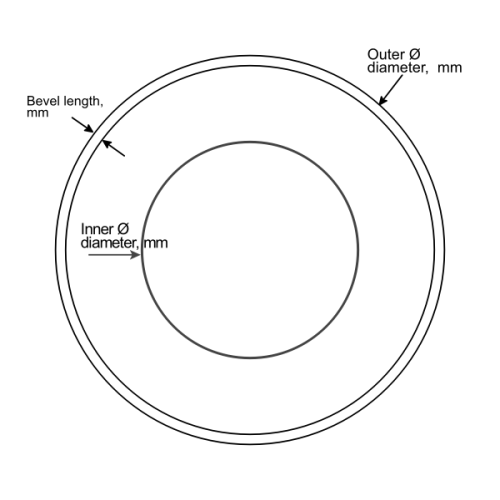
Read how to order machine knives correctly in our guide.
Materials for Industrial Knives and Blades
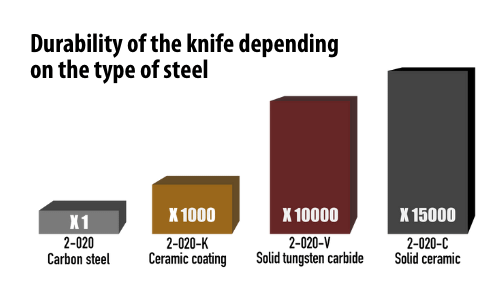
Steel is an alloy of elemental iron and carbon. It is a more robust substance than iron. Chemicals are included to impart certain qualities and features to steel. The physical characteristics of steel are dictated by its chemical makeup.
Consequently, we utilize various steel coatings. Steel, despite its many compositions, may be categorized into three primary families: stainless steel, tool steel, and mild or low-carbon steel.
Carbon is the primary chemical ingredient in steel, which dictates its hardening capacity. Mild steels are characterized by a minimal presence of additives. Tool steels possess specific qualities due to the many additives incorporated into its composition, while stainless steels exhibit a very high concentration of one or two components.
Sollex produces industrial knife and blades in the following materials: Carbon steel, Stainless Steel, Tooling steel, HSS-M2 steel, D2 steel, Tungsten Carbide, and Solid ceramic
Read more about materials for machine knives in our article Overview of Materials for Industrial Machine Knives.
1. Industrial Machine Knives
1.1. Circular Knives
A circular knife, rotary machine knife is a popular and versatile cutting tool for industrial application. It is mainly needed for sharpening and cutting various materials, regardless of their flexibility and hardness.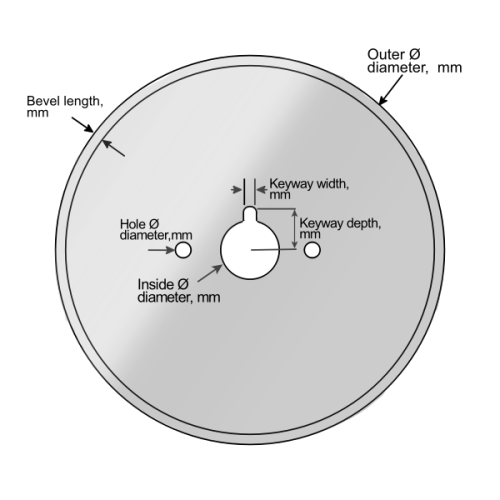 Areas of application of circular knives:
Areas of application of circular knives:
- Metal cutting
- Paper and tissue industries
- Process industry
- Printing industry and typography
- Food and light industry.
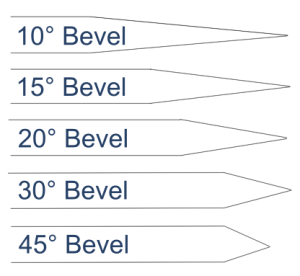 Typical circular slitting blades have a circular shape and a hole in the center, necessary for a firm grip during cutting. The thickness of the blade is selected depending on the materials to be cut. The main characteristics of a circular knife are the outer diameter (the size of the knife from one edge to the opposite edge through the center), the inner diameter (the diameter of the central hole intended for attachment to the holder), the thickness of the knife, bevel and the angle of bevel.
Typical circular slitting blades have a circular shape and a hole in the center, necessary for a firm grip during cutting. The thickness of the blade is selected depending on the materials to be cut. The main characteristics of a circular knife are the outer diameter (the size of the knife from one edge to the opposite edge through the center), the inner diameter (the diameter of the central hole intended for attachment to the holder), the thickness of the knife, bevel and the angle of bevel.
A circular knife has an inner diameter connected to a machine shaft or holder and an outer diameter with a cutting edge designed to cut a specific material. Produced in different materials and properly adjusted, a circular knife is a durable and robust machine knife design. Compared to razor blades, circular knives have longer durability but a less clean cut and generate more dust.
Circular knives are usually used to cut plastic foam, adhesive tape, non-woven, rubber, paper, cardboard, paperboard, labels, insulation materials, cable, circular knives for cutting foil and film. Sollex circular knives can cut through plastic film, carpets, rubber, paper and much more.
1.1. Circular Slitter Blades
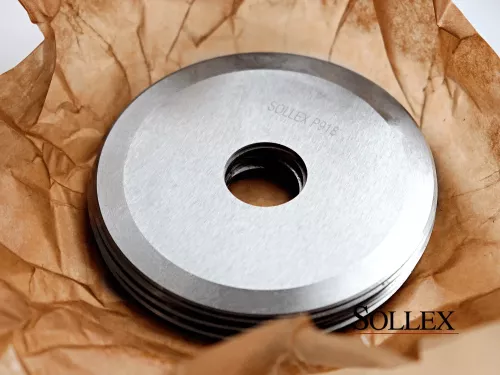 Circular slitter blades or circular slitting knives are knives with sharp cutting edges, low cutting angle and no teeth. As the name suggests, circular slitter blades are mostly used for slitting type cutting operations. The rotary slitter knives are commonly used for shear cutting paper, film and foil products as well as non-woven products. Slitter knives consist of a top slitter blade and bottom slitter blade used for machinery cutting processing.
Circular slitter blades or circular slitting knives are knives with sharp cutting edges, low cutting angle and no teeth. As the name suggests, circular slitter blades are mostly used for slitting type cutting operations. The rotary slitter knives are commonly used for shear cutting paper, film and foil products as well as non-woven products. Slitter knives consist of a top slitter blade and bottom slitter blade used for machinery cutting processing.
Example of Sollex circular knife: Circular slitter knife R71-BLUNT Ø71x10x1.3mm – HSS–M2 blunt grinding – very durable
1.2. Top Male Slitting Knives (Dish knives)
Top slitter knives are also called dished knives as they have a shape of a dished plate. Top slitter knives or dished knives are used for shear cutting film, paper and in the processing industry.
Example of Sollex circular dished knife: Top dished slitter knives RDD105x65x1.2 Ø105x65x1.2mm 60° – dished circular knife – tooling steel HSS – one-sided double grinding
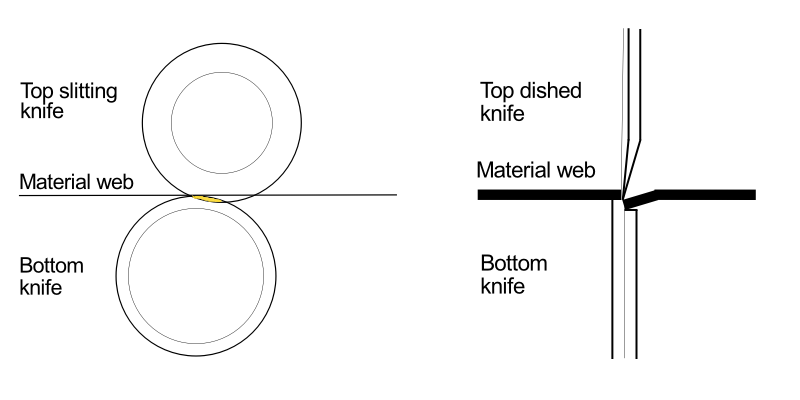
Top and bottom knives work in pairs as the top knife regrinds when in contact with the bottom knife. Top knives are used for cutting material webs and give a really long lasting durability. Dished knives are relatively easy to regrind.
The top slitter blade can be dish shaped or flat shaped with single, double bevel (edge) or square edged. For the score cutting, there is only one blade that works as the roll or sleeve stand as the bottom blade. Besides some of our customers also called top slitter blades as male or front blades.
The cutting edge of these tools is very diverse and depends on the type of material being cut.It can have a single-sided blade, with a ground back or double-sided blade, etc.
- Single bevel S = 0.6-3mm
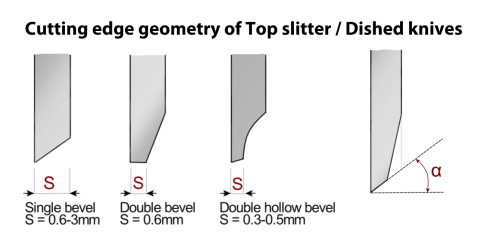
Fields of application: hard materials for ex cardboard, thick plastic-/ aluminum foils
- Double bevel S = 0.5mm
Fields of application: paper, light cardboard, textiles, nonwoven, tissue
- Double hollow bevel S = 0.3 - 0.5mm
Fields of application: thin paper, thin plastic-/ aluminum foils, labels, multilayer paper
Cutting bevel - angle of bevel and material to cut:
- α = 0-10° - metals, laminates, plastics
- α = 30° - paper, foils, laminates, fleece, cardboard, nonwoven, tissue
- <α = 45/ 60° - special application, film industry, multilayer paper
1.3. Bottom Female Knives
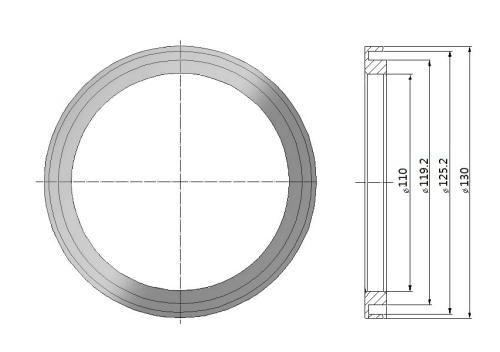 Bottom knives are used in pairs with Top knives (dished knives). By definition the bottom knife is located on the lower shaft compared to the top knife. There are some variations of bottom knife types: multi groove bottom slitters, single and double edge bottom slitters, square edge cutters, solid or tipped carbide bottom knives and cutters etc. It Is also possible to have multiple bottom knives on one knife.
Bottom knives are used in pairs with Top knives (dished knives). By definition the bottom knife is located on the lower shaft compared to the top knife. There are some variations of bottom knife types: multi groove bottom slitters, single and double edge bottom slitters, square edge cutters, solid or tipped carbide bottom knives and cutters etc. It Is also possible to have multiple bottom knives on one knife.
The main principle for a bottom knife is to position the material web and stretch it for the top knife to cut it. In addition, the bottom knife should “regrind” the top knife when it comes in contact with the top knife. Therefore it is absolute imperative that the bottom knife is angled correctly. Without a correct angled bottom knife the knife pair will not perform satisfactory.
Example of Sollex circular bottom knife: Bottom shear slitter knife P804B Ø205x138x20mm – HSS / suitable for P804A dished knife
1.4. Perforator Crush Cutter
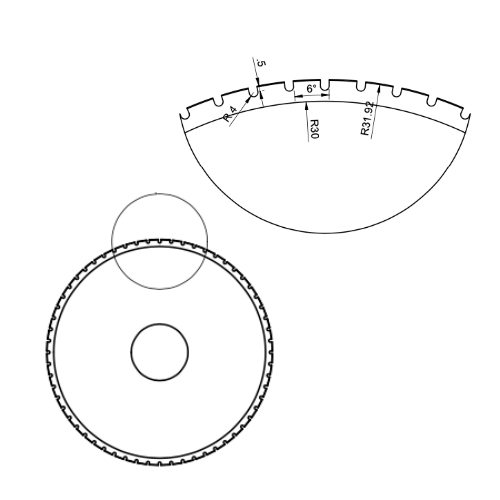 The principle for crush cutting is using a rather blunt knife (Crush cutter) for cutting a material web by pressuring it against a glass hard shaft. Crush cutters is a simple method easy to handle. Crush cutters work well for perforating and profile cuts of material web. Crush cutters are used for thick materials in plastic, rubber, labels and adhesive tapes, textiles and non woven.
The principle for crush cutting is using a rather blunt knife (Crush cutter) for cutting a material web by pressuring it against a glass hard shaft. Crush cutters is a simple method easy to handle. Crush cutters work well for perforating and profile cuts of material web. Crush cutters are used for thick materials in plastic, rubber, labels and adhesive tapes, textiles and non woven.
Important factors to consider when choosing a crush cutter:
- diameter of crush cutter
- radius and cutting angle
- material to cut
One version of the crush cutter is to have a perforated edge. This gives the cut material a perforated cut. Dependent on how many teeth the perforated crush cutter has you can design the finished material perforation. There are two forms to design a perforated cut: straight line and wave form or zig-zag-pattern.
By definition the perforated crush cutter cuts small holes in the material web. Combined these hole make a perforation. Perforated cuts can be used in a vast array of applications. One common example of perforated cuts is small plastic bags put together on a roll. To remove one you simple tear the perforation done by the crush cutter knife.
Example of Sollex circular crush cut knife: Crush cut knife Ø32mm P974E Ø32x16x5mm 46° – two-sided single bevel
1.5. Toothed / Serrated knives
Toothed blades are defined by having a toothed cutting edge. These types of blades are used for perforation of materials and for materials with many entrance points.
 Some examples of teeth are V cut profile, serrated, perforating, and scalloped edge. Toothed blades have different lengths of teeth and different widths between them. Toothed blades are used in different industries such as packaging, rubber converting, tire, food processing, paper cutting and many others. Toothed blades are also suitable for cutting tapes.
Some examples of teeth are V cut profile, serrated, perforating, and scalloped edge. Toothed blades have different lengths of teeth and different widths between them. Toothed blades are used in different industries such as packaging, rubber converting, tire, food processing, paper cutting and many others. Toothed blades are also suitable for cutting tapes.
We stock some serrated blades but manufacture most according to drawings and customer requirements. Serrated blades or perf knives can also be used to cut thin non-woven material.
Serrated knives have a toothed or saw-like edge grinding. Serrated knives have different tooth lengths and different teeth widths. Serrated knives are used with a back-and-forth motion. Optimized for cutting fabrics, belts and ropes, and other textured materials. Serrated blades also perform well on soft and flexible materials. You can also use serrated blades or perforated knives to cut thin nonwoven material.
The disadvantage of serrated blades is fraying and when the blade dulls it is very hard to resharpen. Sharpening serrated blades is mainly done bye hand and is relatively time consuming because sharpening must occur between each pair of teeth.
In addition serrated blade cuts are less clean compared to cuts by a straight edged knife. A successful serrated knife is a combination of the right angle of the point and the distance between the teeth.
A scalloped blade is similar to a serrated and toothed blade but the design is more scalloped. This industrial blade type is seldom used as the scalloped tip of the blade is fragile and hard to handle.
Industrial saw knives are used for cutting hard materials such as wood. Saw knives have specific teeth designs optimized for each material to be cut. Primary usage for saw knives is to cut wood.
Example of Sollex toothed knife: Machine knife I-31892 toothed 255x29x1.2mm HSS–M2 to cut non woven, tape, plastic
1.6. Trapezoid Blades
A trapezoid blade is by definition a blade with its base longer than its top. A typical Trapezoidal blade is a one edge blade where the grinded edge is longer than the non grinded back of the blade. This is probably the most common blade in the world found in numerous box cutters and hand held knives all over the world. This trapezoidal blades are made by grinding a steel coil with one edge and leaving the back non grinded. Trapez is a German short name for Trapezoidal blades. Customers who buy our custom trapezoidal blades include world leaders in the automotive and food industries.
Example of Sollex industrial trapezoid blade: Trapezoid blade 752V 52mm with 3 cutting edges – Solid tungsten carbide
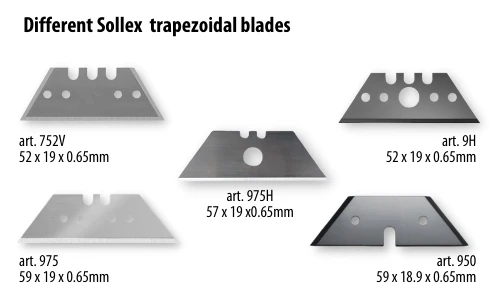
However, there are other versions of this blade type. A good example of a Trapezoidal knife blade with a different grinding is the Martor 614 blade, which is no longer produced by that company, but Sollex produces the 950 blade, which is exactly the same blade in the same steel. The blade is unusual in that it is sharpened on two short sides. Thus, the blade of the Martor 614 knife has two edges, but is only sharpened with a one-sided double-bevel grinding. We have previously described the Martor 614 knife blade as a knife blade with a long straight edge on the sides of the u-sharpener. The Martor 614 knife blade, or as we at Sollex call it 950, is used to cut leftover plastic horizontally when, for example, two coils of plastic film are joined.
1.7. Pointed Blades
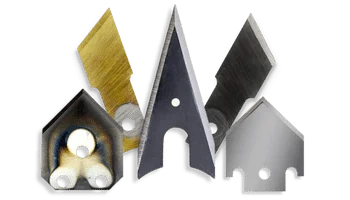 Sharpened pointed blades are most often irregularly shaped, with one or more ends sharpened to be used in industrial machines. The shape of this type of machine knife determines its application area, namely not deep cutting off material, but surface and precise cutting.
Sharpened pointed blades are most often irregularly shaped, with one or more ends sharpened to be used in industrial machines. The shape of this type of machine knife determines its application area, namely not deep cutting off material, but surface and precise cutting.
The cost of a pointed tip blade is incrementally higher than a blade having a simple straight edge shape. The reason is that a pointed blade is much harder to grind compared with a blade that easily can be grinded on a steel coil.

Sollex pointed blades have many different applications. The high quality steel in the pointed blades makes them especially suitable for challenging work. If you need to cut materials such as hose or cardboard, we have many different models to choose from. Some blades are coated with a ceramic coating, which considerably extends the durability of the tip blade. The edge coating acts as a protection for wear and tear. We also manufacture pointed tip blades in solid tungsten carbide with extreme performance and durability.
Example of Sollex industrial pointed blades: Pointed blade 824K double edge 100° ceramic coated
1.8. Granulator Knives & Pelletizer Blades
 The definition of a granulating knife is a 3-5mm thick knife which mill leftover materials to be recycled. When recycling plastics the first step is to grind down the material. For this grinding process Granulating knives grind the material to a pulp. When doing so it is important have not too hard knives as they will easily break off small pieces or tips off the edge when granulating plastic materials for recycling. The granulator knives moves against each other which makes it important to have exactly dimensioned knives.
The definition of a granulating knife is a 3-5mm thick knife which mill leftover materials to be recycled. When recycling plastics the first step is to grind down the material. For this grinding process Granulating knives grind the material to a pulp. When doing so it is important have not too hard knives as they will easily break off small pieces or tips off the edge when granulating plastic materials for recycling. The granulator knives moves against each other which makes it important to have exactly dimensioned knives.
A pelletizing machine blade is a blade designed for recycling plastic left-overs and cut it into new pellets. After granulating the recycled material it is heated to become a paste. The paste is pushed though fine pipes or tubes and when leaving the pipe a Pelletizer blade cut down the paste into small pellets. The pellet blade is tensed to the plane (by end of the pipe or tube) to cut or plane the pellets into perfection. Hence the special design of the pelletizer blade. The design is made to have flexibility in the blade so the cut is smooth along the end of the tube. There are pellet blades of various dimensions and qualities with many designs are available with different cutting angles and hardness of the steel.
Example of Sollex pelletizing plastic recycling blades: Die Face Cutter Pelletizer Blade L23 46mm for plastic recycling industry
1.9. Long Machine Knives
 Blades that are thicker than 1mm we generally name knives. Long knife blades are typically found in machines cutting long materials. It is possible to make knives that are more than 3 meters long. We use the name long knife blades for long blades that are thicker than one millimeter and longer that 150 millimeter.
Blades that are thicker than 1mm we generally name knives. Long knife blades are typically found in machines cutting long materials. It is possible to make knives that are more than 3 meters long. We use the name long knife blades for long blades that are thicker than one millimeter and longer that 150 millimeter.
Read about how Sollex manufactured and delivered a three-meter serrated knife for a Swedish nonwoven fabric manufacturer here in our blog.
1.10. Other Industrial Blades
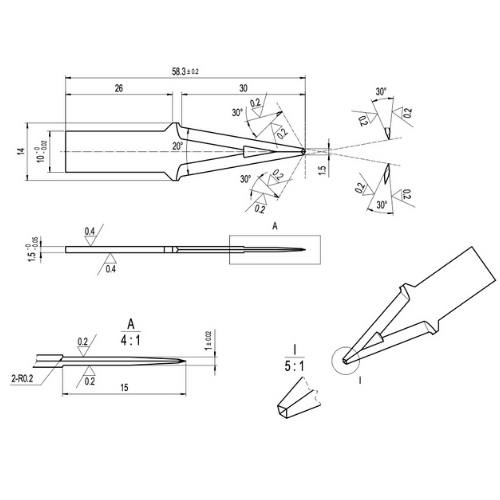 Our range of special knives and machine knives includes a variety of shapes, grinds, steels and hardenings. Drawing on Scandinavian quality standards, we have developed a unique range of trapezoidal blades and individually sharpened knives that are suitable for many applications and cutting processes.
Our range of special knives and machine knives includes a variety of shapes, grinds, steels and hardenings. Drawing on Scandinavian quality standards, we have developed a unique range of trapezoidal blades and individually sharpened knives that are suitable for many applications and cutting processes.
In addition to our wide range of knife blades and additional blades for safety knives, we offer trapezoidal knife blades with a unique design, lateral sharpening, special sharpening and hole pattern. Our company's particular strength is in knives used in the production of plastic film, plastic and packaging.
2. Industrial Slitter Razor Blades
An industrial razor blade is defined by its thin thickness and sharp grinding. This gives razor blades its cutting characteristics, clean cut, and the least amount of dust. The beauty of the razor blade is its simple design and efficient cutting performance. There are many types and versions of razor blades used in machines all over the world.
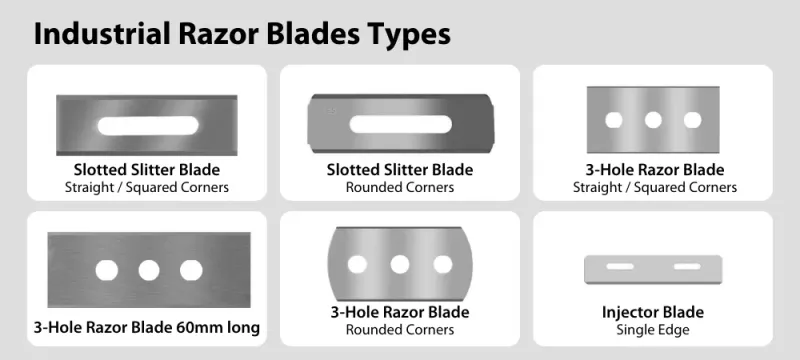
Three general types of razor blades are used: 3-hole razor blades, slotted slitter blades, and injector blades.
2.1. 3-Hole Razor Blades (straight or rounded corners)
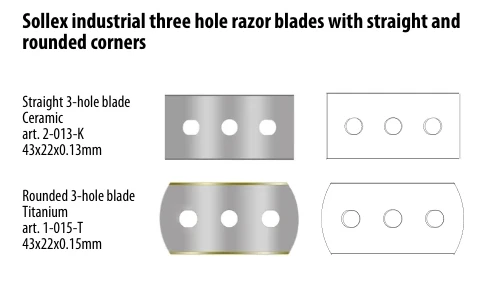 The three hole (3-hole) razor blade is the essence or definition of a razor blade. Initially it was developed with round corners for easier and safer shaving. The user could hold the blade in the rounded sides without touching the edge. When three hole blades was abandoned for shaving in the 1930ies the rounded design was quickly replaced by straight three hole blades for industrial usage.
The three hole (3-hole) razor blade is the essence or definition of a razor blade. Initially it was developed with round corners for easier and safer shaving. The user could hold the blade in the rounded sides without touching the edge. When three hole blades was abandoned for shaving in the 1930ies the rounded design was quickly replaced by straight three hole blades for industrial usage.
In an industrial perspective a straight three hole blade generates less waste when produced and gives better cutting performance due to less stress in the steel.
Most three hole blades are 43mm long and 22mm wide. They are available in a vast number of thicknesses: 0.06mm, 0.08mm, 0.10mm, 0.13mm, 0.15mm, 0.20mm, 0.28mm, 0.30mm, 0.40mm.
Three hole razor blades are made in stainless steel, carbon steel, steel with coatings, solid tungsten carbide, and ceramics. They are used to cut many different materials such as: plastic film, plastic foil, aluminium, tape, non woven, and paper products.
Read more about razor slitting here.
Example of Sollex 3-hole razor blades: Straight 3-hole blade 2-020-Z 0.20mm Zero Friction 43x22x0.20mm – to cut thin stretch plastic film
2.2. Slotted Slitter Razor Blades
Slitter blades or Slotted slitter blades are used in many different machines for slitting materials. Industrial slotted razor blades have dimensions of 57x19 mm, and are rectangular in form. In comparison to industrial blades with 3 holes, the slotted slitter razor blade's relatively robust design and single oblong slot in the middle allow it to convert and cut not only simple plastic films like PE or PP, but also thicker, abrasive materials with additives and impurities at a high speed, like recycled or calcium carbonate plastic films.
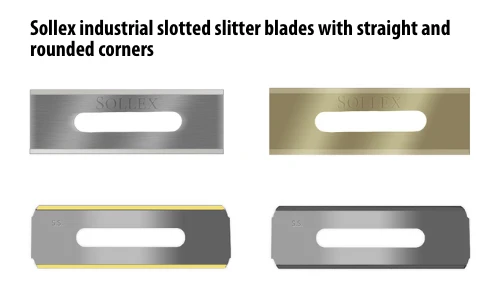
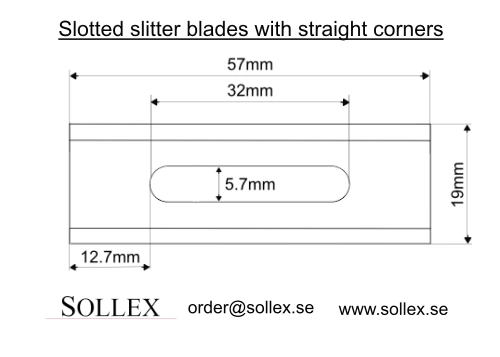
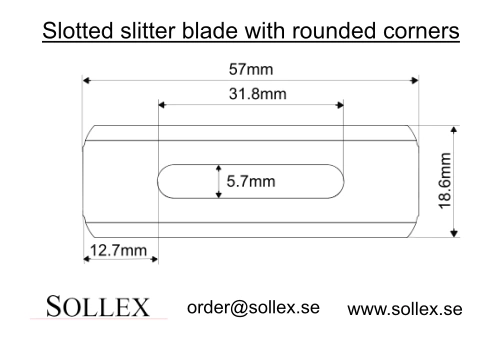
The slotted slitter blade is the ultimate blade for flexible packaging materials and plastic bags. In general there are four different qualities of Slotted slitter blades. Stainless steel, coated and different hard metals and ceramics. Slotted slitter blades are made in 0.40mm and 0.20mm thicknesses. Durability and performance is very dependent on the material that is cut.
A basic slitter blade may last 20 minutes when cutting tough abrasive film with white additives. The same blade with a ceramic coated edge, such as Slitter Blade Ceramic Coating 5K, will last two weeks. If the same film contains a lot of ink and printing, the fully coated blade Slitter Blade Full Ceramic Coating 5X will perform much better. For a completely different, thin, stretched film at high speeds, the durability of the edge is not as important as the friction of the blade. In this case, the Slitter blade zero-friction 5Z offers such low friction and cutting performance that it will last for weeks. Solid tungsten carbide razor blades 5V are used for heavy duty applications, thick flexible materials, highly abrasive films, or plastic films with additives.
Example of Sollex slotted slitting razor blades: Slitter blade straight 0.40mm 5Q Ceramic 57x18.8x0.40mm – to cut white plastic films, foils with a high % of pigments
2.3. Injector Blades
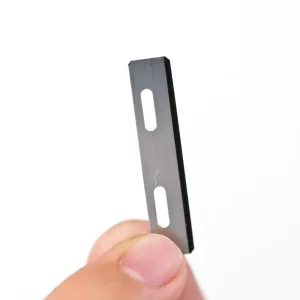 Injector blades are small razor blades ideal for heavy industrial use. Injector blades were originally developed as razor blades for shaving. The original Gillette blade was big and clumsy and the design of the injector blade made it easy to fit in a handle. The blade has one single edge. Today injector blades are mostly used for industrial purposes. The size of the blade is pretty tiny: 38x8x0.25mm or 1.496”x0.315”x 0.01”. That means that the injector razor blade can be fitted in really small areas of your machines. Today injector blades are placed in products but many users cut plastic film and foil with Injector blades.
Injector blades are small razor blades ideal for heavy industrial use. Injector blades were originally developed as razor blades for shaving. The original Gillette blade was big and clumsy and the design of the injector blade made it easy to fit in a handle. The blade has one single edge. Today injector blades are mostly used for industrial purposes. The size of the blade is pretty tiny: 38x8x0.25mm or 1.496”x0.315”x 0.01”. That means that the injector razor blade can be fitted in really small areas of your machines. Today injector blades are placed in products but many users cut plastic film and foil with Injector blades.
Example of Sollex injector razor blade: Injector blade 642K ceramic coated 38x8x0.25mm – to cut white plastic film with masterbatch, printed plastic film
Coatings of Industrial Machine Knives for Better Performance
Steel quality defines how well a knife performs. Coatings on the blade can be used to change the characteristics of the cutting application. The edge coating on the blades acts as a protecter against the wear and tear of the material.
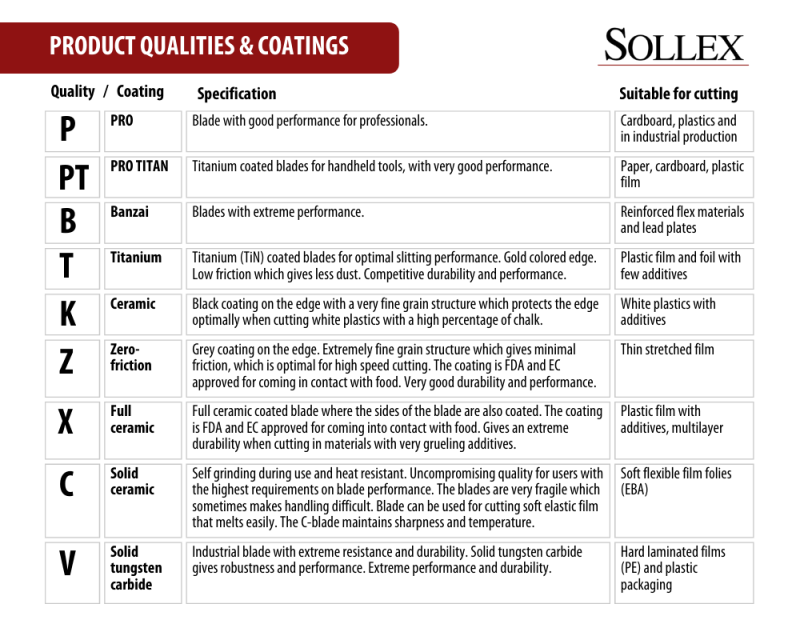
Coated industrial blades change the cutting properties of the blade. This makes coated blades ideal for heavy industrial use. With coatings we protect the blade from abrasion, to reduce friction, and increase performance and durability. If you have to cut materials with glue and dirt, coatings can be used to reduce glue and dirt sticking to the blade.
Common materials used for coating blades are titanium (-T), ceramic (-K), zero friction (-Z) and tungsten carbide (-V). Sollex ceramic-coated blades are FDA and EC approved, which means that they can come into contact with food.
If you are going to cut thin stretched film ( ex. LLDPE) with an automatic or semi-automatic wrapper, our Z-coating is perfect. For white plastic film (Poly film with additive chalk), Blades with K-coatings are a wise choice.
Machine Knives for Industrial Applications to Order
 Using the right industrial knives brings prosperity, peace of mind, and a better end product. By combining different sizes, designs and materials, you can achieve the cutting performance you need. If you need inspiration, we recommend that you download our PDF catalogs with the best selection of knives and blades for industry.
Using the right industrial knives brings prosperity, peace of mind, and a better end product. By combining different sizes, designs and materials, you can achieve the cutting performance you need. If you need inspiration, we recommend that you download our PDF catalogs with the best selection of knives and blades for industry.
All the machine knives we offer are used by previous customers. If you didn't find what you were looking for, it's good to know that Sollex is a reliable European manufacturer of industrial blades. We will manufacture the right special knife to your drawing, part number or sample.
If you would like us to visit your facility, let us know and we will be happy to come to you.
If you have any questions about machine tool knives, contact Sollex at +4635-15 75 00 or by email order@sollex.se.

